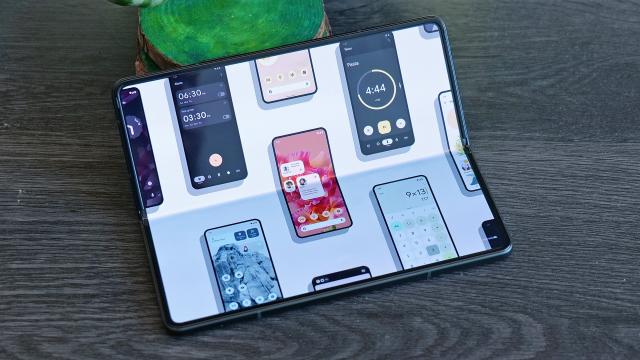Even though we’re still waiting for the official release of Android 12, expected to drop sometime next week, a new leak has just shed some light on a future Android update that promises some big upgrades for foldable phones.
Over the past few years, Google has moved away from doing big mid-cycle Android updates, so the mere idea of a major patch following the release of Android 12 is somewhat unusual. In fact, it’s not even clear what this upcoming Android update will be called or when it will be released, so for now people are simply referring to the new build as Android 12.1.
According to XDA Developers, which was provided a leaked build of Android 12.1 from a source, the update packs in a host of new features and upgrades designed specifically for foldable phones (particularly large-format foldables like the Galaxy Z Fold 3). XDA predicts that the release of Android 12.1 will most likely coincide with the release of Google’s rumoured foldable Pixel.
One of the biggest changes in Android 12.1 is the way Google has adjusted Android 12’s UI, with Google adding a second pane to elements like the notification shade, the settings menu, lock screen, and even the stock Android launcher for devices with larger than normal screens. The goal of adding a second panel is to provide more on-screen information and to better take advantage of larger format foldables, so you can see notifications and your device’s quick settings at the same time. And while Samsung’s One UI on the Galaxy Z Fold 3 already does something similar for the Z Fold 3’s settings menu, it’s nice to see Google working on wider support for future non-Samsung foldables.
One thing I forgot to initially mention is that there are now three photos in Settings > Display > Colors you can use to compare the different color modes. pic.twitter.com/nO2BtaUDFt
— Mishaal Rahman (@MishaalRahman) September 27, 2021
Another big change for Android 12.1 is the addition of a taskbar, similar to what you might get laptop or desktop. Now technically, there’s already code to support a taskbar hidden inside Android 12, but in Android 12.1, Google has expanded upon the taskbar by adding support for quickly switching between apps, dragging and dropping apps to launch a split-screen view, and the ability for the taskbar to seamlessly transform into Android 12’s app drawer depending on the situation.
The Android 12.1 taskbar is similar to the taskbar Samsung added to One UI for the Galaxy Z Fold 3, except that instead of being displayed vertically on the left or right side of the phone’s screen, Android 12.1 positions its taskbar horizontally across the bottom. I would actually prefer that as it more closely mimics desktop taskbars in macOS, Windows, and others. Unfortunately, it seems the Android 12.1 taskbar can currently only display five apps at a time, which seems unusually limited, so here’s hoping Google bumps up that number before Android 12.1’s official release.
When it comes to multitasking, it seems Google is borrowing another page from Samsung’s playbook by adding support for App Pairs, allowing you to launch two apps in split-screen with a single tap. But Google is differentiating from Samsung with its split-screen UI, which in Android 12.1 now features a more pronounced divider pane and potentially the ability to launch an app into split-screen view directly from your notification panel, though XDA says that last feature is still “being considered” and may not make the final release.
It seems Google is also looking to building upon new features in Android 12 in Android 12.1 with the addition of new boot animations, wider support for dynamic colours and theming, and a press and hold option that lets you customise how long you need to hold your phone’s power button before it summons the Google Assistant.
With Android 12.1, Google may be aiming to provide better support for foldable phones, particularly large-screen foldables that aren’t made by Samsung. And while foldable phones are still a somewhat niche category of devices, without proper software support, fancy new hardware can only go so far, so it’s really encouraging to see Google add these new features in Android 12.1 instead of waiting until Android 13’s official release next year.
